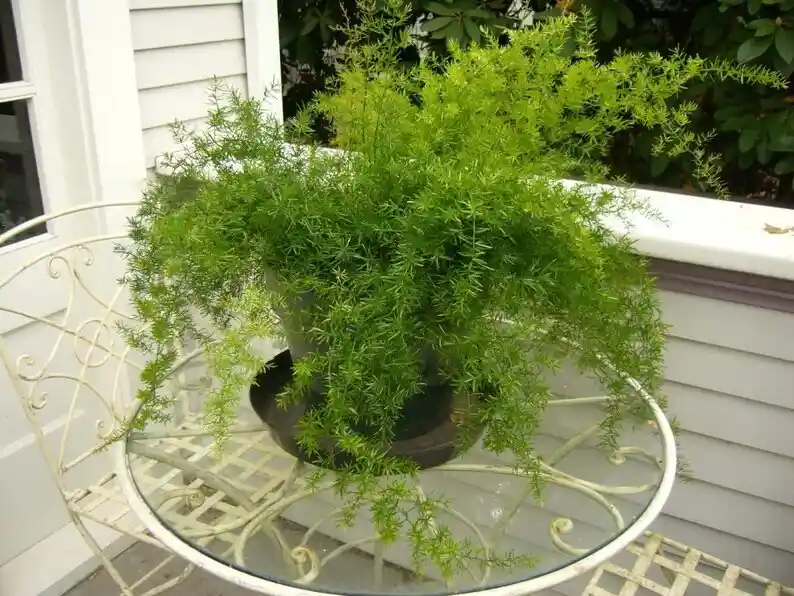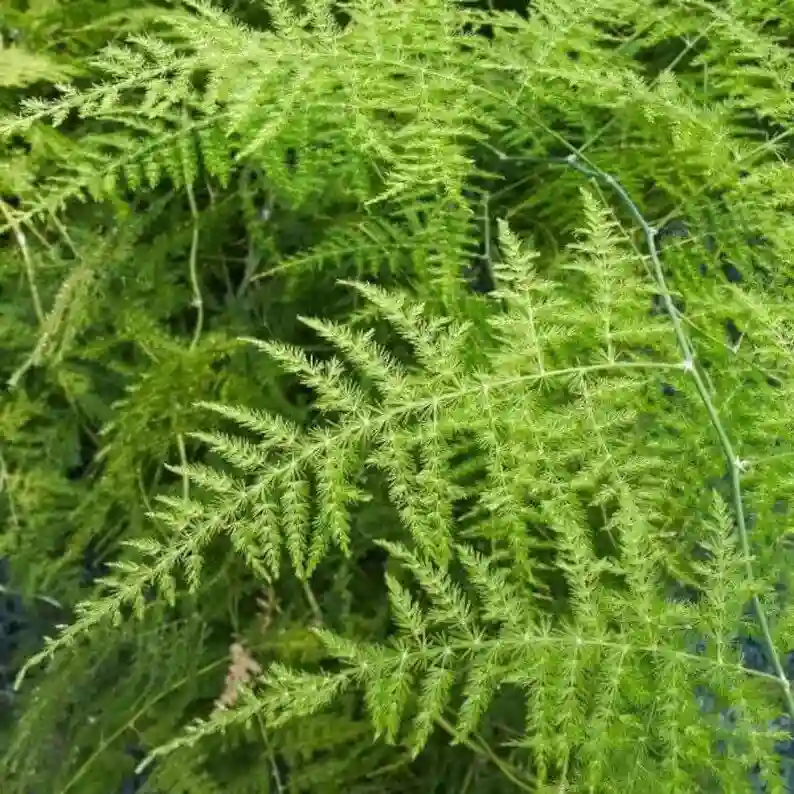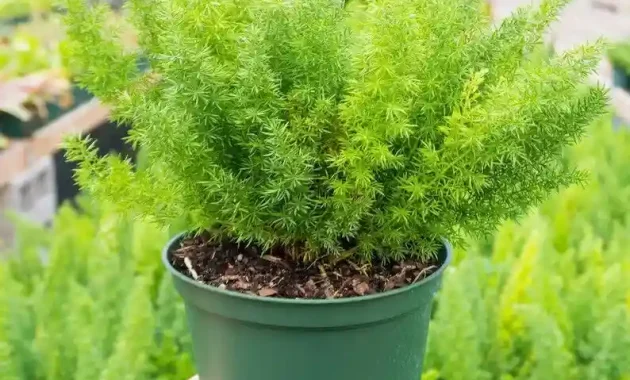Asparagus ferns are an excellent addition to any indoor or outdoor garden. With its delicate foliage and wispy fronds, this plant adds a unique texture and charm to any space. However, with so many different types of asparagus fern out there, it can be challenging to know which one is right for you.
In this comprehensive guide, we will explore the different types of asparagus fern, their unique characteristics, and the best techniques for growing and propagating them. Whether you’re looking to add some greenery to your home or enhance your outdoor landscaping, we’ve got you covered. So, let’s dive in and discover the amazing world of asparagus fern!
Understanding Asparagus Fern: An Introduction to a Versatile Plant
The Asparagus Fern, also known as Asparagus densiflorus, belongs to the lily family and is native to South Africa. Although the name suggests it is a fern, it is actually a member of the asparagus family.
There are several different species and cultivars of Asparagus Fern, making it a versatile plant for both indoor and outdoor spaces. The most commonly known is the Asparagus densiflorus ‘Sprengeri’, which has delicate, fern-like leaves that cascade downward and are commonly used in hanging baskets or as ground cover.
Other popular species include Asparagus densiflorus ‘Meyersii’, which has a denser and bushier growth pattern, and Asparagus setaceus, which has longer and more delicate fronds.

The Origins of Asparagus Fern
Asparagus Fern is native to South Africa, but it has become a popular plant around the world due to its versatility and ease of cultivation. Its long history of use as an ornamental plant dates back to the late 19th century, and it has been grown commercially as a crop since the mid-20th century.
| Common name | Scientific name |
|---|---|
| Asparagus Fern | Asparagus densiflorus |
| Emerald Fern | Asparagus densiflorus ‘Sprengeri’ |
| Plume Asparagus | Asparagus setaceus |
Asparagus Fern has also been used for medicinal purposes in traditional herbal medicine. The plant is believed to have diuretic properties and has been used to treat ailments such as urinary tract infections, rheumatism, and arthritis.
Overall, Asparagus Fern is a versatile and hardy plant that can thrive in a variety of conditions. Whether you’re looking for a low-maintenance indoor houseplant or a lush ground cover for your garden, Asparagus Fern is a great choice.
Growing Asparagus Fern Indoors: Tips for a Beautiful Houseplant
Asparagus ferns are a popular houseplant due to their attractive foliage and easy maintenance. However, to ensure your asparagus fern thrives indoors, it’s important to provide the proper growing conditions and care. Here are some tips for successfully growing asparagus fern as a houseplant:
Choosing the Right Pot and Soil
When selecting a pot for your asparagus fern, opt for one with drainage holes to prevent water buildup. A sandy soil mix is best, as it allows for proper drainage and promotes healthy root growth.
Light Requirements
Asparagus ferns prefer bright, indirect light, so place your plant near a window with filtered light. Avoid exposing your fern to direct sunlight, which can scorch its delicate leaves.
Watering
Water your asparagus fern once a week, allowing the soil to slightly dry out between waterings. Be careful not to overwater, as excessive moisture can lead to root rot. As a tropical plant, asparagus ferns appreciate moderate humidity levels, so consider misting your plant every few days.
Temperature Considerations
Asparagus ferns do best in temperatures between 60-75°F. Avoid placing your fern in drafty or chilly areas, as it prefers consistently warm environments.
Propagation Techniques
Propagating your asparagus fern is an easy way to grow more plants and expand your collection. You can propagate your ferns by dividing the root crowns, planting seeds, or taking stem cuttings. Each method has its own advantages and drawbacks, so research which propagation method is most suitable for your needs.
By following these tips, you can enjoy the beauty of asparagus ferns in your indoor space. Remember to regularly monitor your fern’s growth and adjust your care routine as necessary to ensure long-lasting health and vitality.

Outdoor Asparagus Fern Varieties: Enhancing Your Landscape
If you’re looking to add some greenery to your outdoor space, asparagus fern is a great option. With its delicate, feathery foliage and spreading habit, this plant can add texture and interest to any landscape. Here are some of the best types of asparagus fern for outdoor cultivation:
| Variety | Size | Hardiness |
|---|---|---|
| Sprenger’s asparagus fern (A. densiflorus ‘Sprengeri’) | 2-3 feet tall and wide | Zones 9-11 |
| Plumosa fern (A. setaceus ‘Plumosus’) | 1-2 feet tall and wide | Zones 9-11 |
| Ming fern (A. retrofractus) | 2-3 feet tall and wide | Zones 9-11 |
Sprenger’s asparagus fern, also known as sprengeri fern, is a popular choice for outdoor landscaping due to its long, arching stems that bear fluffy, needle-like leaves. The plumosa fern, on the other hand, has a more delicate appearance, with lacy, bright green foliage that adds a soft, airy touch to any garden. Finally, the ming fern features tightly packed, needle-like leaves on upright, branching stems, giving it a more structured appearance.
When planting asparagus fern outdoors, choose a spot with well-draining soil and partial to full shade. Keep the soil consistently moist, but not waterlogged, and fertilize regularly during the growing season to encourage lush, healthy growth. Asparagus fern is generally resistant to pests and diseases, but keep an eye out for spider mites and mealybugs, which can sometimes be a problem.
With their graceful form and easy-care nature, outdoor asparagus fern varieties are an excellent choice for anyone looking to enhance their landscape with a touch of green.
Essential Care Tips: Maintaining Healthy Asparagus Ferns
Asparagus ferns are relatively low maintenance plants, but they still require some care to thrive. Here are some essential tips to keep your asparagus ferns healthy:
- Watering: Asparagus ferns prefer consistently moist soil, but avoid overwatering as this can lead to root rot. Wait until the top inch of soil is dry before watering again, and make sure there is adequate drainage.
- Light: Asparagus ferns prefer bright, indirect light, but can tolerate some shade. Avoid direct sunlight, which can scorch the leaves.
- Temperature: Asparagus ferns prefer temperatures between 60-70°F (15-21°C). Avoid exposing them to cold drafts or extreme heat.
- Humidity: Asparagus ferns prefer high humidity, so consider misting them regularly or placing a tray of water near the plant to add moisture to the air.
- Fertilizer: Asparagus ferns benefit from regular fertilization during the growing season (spring and summer). Use a balanced fertilizer every 2-3 weeks.
- Pruning: Asparagus ferns can become unruly if left unpruned, so consider trimming them back periodically to maintain their shape and prevent them from becoming too leggy.
- Pests and Diseases: Asparagus ferns are relatively pest-resistant, but can be susceptible to spider mites, scale insects, and mealybugs. Keep an eye out for any signs of infestation and treat with an appropriate insecticide if necessary.
By following these care tips, you can ensure your asparagus ferns remain healthy and vibrant, adding a touch of natural beauty to your indoor or outdoor space.
Popular Asparagus Fern Species: A Closer Look
Asparagus ferns come in a variety of species, each with unique characteristics and suitability for different growing conditions. Here are four popular asparagus fern species to explore:
| Species | Characteristics |
|---|---|
| Asparagus densiflorus | This species is valued for its fine, delicate foliage that forms feathery plumes. It prefers bright, indirect light and can grow up to 2 feet tall. |
| Asparagus sprengeri | Also known as the ’emerald fern,’ this species has long, cascading vines with needle-like leaves that add a lush, trailing effect to any setting. It thrives in moderate light and can reach up to 4 feet in length. |
| Asparagus setaceus | This species, also called the ‘lace fern,’ has delicate, lacy foliage that creates an airy, ethereal feel. It is easy to care for and can tolerate a range of light levels, although it prefers bright indirect light. It can reach up to 3 feet tall. |
| Asparagus plumosus | Also known as the ‘feather fern,’ this species has fine, fern-like foliage that is perfect for adding texture and softness to any arrangement. It can grow up to 2 feet tall and prefers bright, indirect light. |
Remember to consider the size, light and humidity requirements, and suitability for indoor or outdoor growing when selecting an asparagus fern species. With proper care, these versatile plants can thrive and add beauty to any space.
Propagating Asparagus Fern: Methods and Techniques
Asparagus ferns are relatively easy to propagate and propagate quickly, making them a popular choice for gardeners and plant enthusiasts. There are a few different methods to propagate asparagus fern, each with its own advantages and disadvantages.
Dividing Root Crowns
Dividing the root crowns is the most common method of propagating asparagus fern. This technique is best used in the spring or early summer when the plant is actively growing. Carefully remove the plant from its pot or garden bed and use a sharp, clean knife to divide the root clump into smaller sections. Each new section should have a few healthy stems and roots.
Replant the new sections in a well-draining potting mix and water thoroughly. Keep the soil moist but not waterlogged and place the new plants in a bright, indirect light.
Planting Seeds
Asparagus fern seeds are readily available, but this method is less common than dividing the root crowns. Plant the seeds in a well-draining potting mix and keep the soil moist but not waterlogged. The seeds should germinate within a few weeks.
Once the seedlings have developed their second set of leaves, transplant them into individual pots or into a garden bed. Be sure to provide them with the right amount of light and water for best results.
Taking Stem Cuttings
Asparagus ferns can also be propagated through stem cuttings. This method is best used in the spring or early summer when the plant is actively growing. Use clean, sharp scissors or a knife to take a stem cutting from a healthy plant, making sure to include a few leaves and a node.
Dip the cut end of the stem into rooting hormone, and plant it into a well-draining potting mix. Water the soil well and cover the cutting with a plastic bag to create a small greenhouse environment. Keep the soil moist and place the cutting in bright, indirect light.
After a few weeks, the cutting should begin to root. Remove the plastic bag and continue to care for the new plant as you would any other asparagus fern.
Conclusion: Choosing the Right Asparagus Fern for Your Needs
Asparagus ferns are a versatile and attractive addition to any indoor or outdoor space. With a variety of species and cultivars to choose from, it’s important to select the right type of asparagus fern based on your individual needs and growing conditions.
When choosing an indoor asparagus fern, consider the amount of light your space receives and the size of the plant you want. The foxtail and plumosa varieties are great options for smaller spaces, while the sprengeri variety can grow quite large and requires more room to thrive.
If you’re looking to add asparagus ferns to your outdoor landscape, consider the meyerii or densiflorus varieties, which are well-suited for hot climates and can withstand full sun exposure. The sprengeri and plumosa varieties can also work well in outdoor settings if they’re placed in partially shaded areas.
Regardless of the type of asparagus fern you choose, it’s important to provide proper care and maintenance to ensure it thrives. Be sure to keep the soil moist, but not waterlogged, and avoid letting the plant dry out completely. Asparagus ferns also prefer bright, indirect light and temperatures between 60-70 degrees Fahrenheit.
By following these tips and taking the time to select the right asparagus fern variety for your needs, you can enjoy the beauty and benefits of this versatile plant for years to come.


